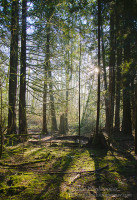Post processing is a necessary step in creating a great photo. Back in the day, I had binders full of negatives, slides, and proof prints and I would spend hours in the darkroom burning, dodging and manipulating prints. Today, I use Adobe’s Lightroom and Photoshop{{1}} to organize and to make my images come alive.
In this post, I will describe my typical workflow and how I organize my images. I have written (and will no doubt write more) posts on various retouching processes.
- Import images to Lightroom… I also add keywords associated with location, or anything else all the images from the shoot have in common. I have a preset that renames my raw files with the date, and then imports them into a year/month/day folder hierarchy{{2}}.
- Delete any obvious screw ups.
- Quick rating. I do a quick run through of the photos, ranking from 1 to 5 stars. One star means it is not a good photo, but I want to keep it for some reason, maybe an image I just want to keep for reference purposes. 3 stars is decent and I may want to come back to work on the image. 5 stars is an awesome portfolio quality image.
- next I review and mark any not worth keeping as a discard (x), and possibly mark others with one of several custom colour labels{{3}} such as “Model Release”, “Do Not Publish” or “To Work On”.
Now the images are catalogued and rated. I may leave the files alone and come back to them later, or, if an image or two are inspiring, I will start tweaking them right away.
I usually do white balance, and maybe exposure compensation in Lightroom. I could do it in Photoshop, but I would have to transfer as a smart object, and I find that is more trouble than it is worth. I may do some other global adjustments in contrast, etc before opening the file in Photoshop.
If you right click on an image and select “Open in Photoshop” this will create a PSD copy with all the cataloguing of the original raw file. All changes made in Photoshop will be reflected on this copy. At this point, I will drop the original raw file to 2 stars, as the Photoshop file is the main version of this image, and I don’t want the unedited raw file to show up in searches or smart catalogues.
At the end of the day, I will have all my raw files with some keywording and a ranking. Some of them will have duplicate Photoshop files with the same keywording. I can also drag images to different catalogues, but that is another article.
[[1]]There are other programs and workflows that may work as well or better for some people, however I have been using Photoshop for a long time and it is what I am comfortable with…[[1]]
[[2]]I also have a top level folder for “jobs”, i.e. commercial work, that is subdivided into year/month/day folders. I use keywords to describe the job and client.[[2]]
[[3]]You can set custom label text for your colour labels to make it easier to categorize images. Some people use keywords instead, but I find this can mess up searching. For example, if you search for “publish” you will also get all the files keywords “Do not publish”.[[3]]
